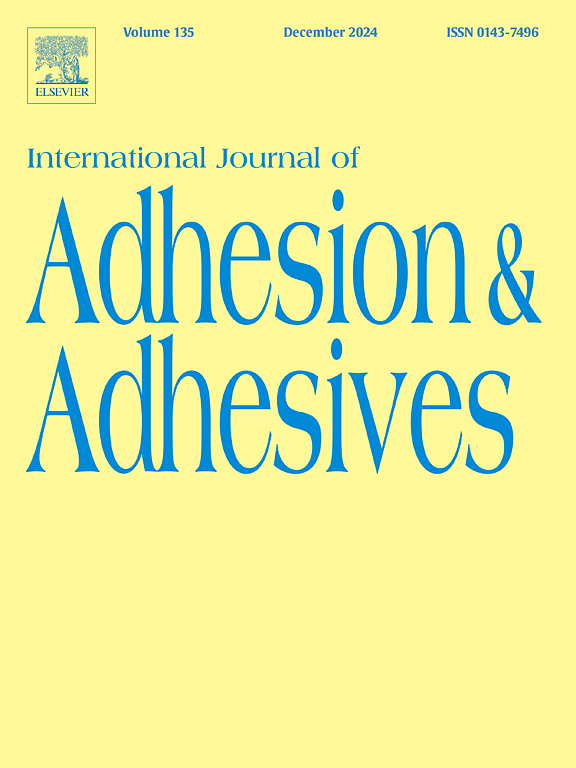PBF-LB制造Ti6Al4V结构件的激光处理
IF 3.5
3区 材料科学
Q2 ENGINEERING, CHEMICAL
International Journal of Adhesion and Adhesives
Pub Date : 2025-07-26
DOI:10.1016/j.ijadhadh.2025.104114
引用次数: 0
摘要
激光粉末床熔合(PBF-LB)加工的Ti6Al4V零件具有固有的表面粗糙度特征,通常有利于结构粘合剂的粘合。然而,先前的研究表明,PBF-LB-Ti6Al4V的有效表面处理仍然是防止粘合界面失效的关键。特别是,激光处理作为一种表面制备工艺已经显示出巨大的潜力。因此,本文研究了三种不同激光影响下激光处理对金属-金属接头粘接性能的影响。采用扫描电子显微镜、激光共聚焦扫描显微镜和离子束截面抛光对表面进行了表征。用x射线衍射法测量了激光诱导下钛的残余应力。通过离心黏附试验评估拉伸加载的准静态粘结强度,通过双悬臂梁试验评估I型加载的准静态粘结强度。通过单阶搭接试验,考察了表面处理对环境耐久性和疲劳性能的影响。结果表明,纳米孔氧化层的厚度和均匀性是影响准静态和疲劳粘接性能的决定性因素。激光通量对粘结强度的影响是显著的,但对拉伸载荷没有影响。在最高的激光辐照量下,获得了最佳的结合性能,产生了更厚且高度均匀的氧化层。与表面状态(即脱脂pbf - lb表面)相比,激光处理的拉伸结合强度提高了52%,I型断裂韧性提高了约600%。热液时效后的拉伸剪切结合强度提高了79%,疲劳寿命也显著延长。本文章由计算机程序翻译,如有差异,请以英文原文为准。
Laser treatment of PBF-LB manufactured Ti6Al4V parts for structural adhesive bonding
Laser powder bed fusion (PBF-LB) processed Ti6Al4V parts exhibit inherent surface roughness features that are generally favorable for structural adhesive bonding. However, previous studies have shown that effective surface treatment of PBF-LB-Ti6Al4V is still crucial to prevent interfacial failure in adhesive bonds. In particular, laser treatment has demonstrated significant potential as a surface preparation process. Therefore, in this work, the effects of laser treatment on the adhesive bond performance of metal-metal joints were investigated for three different laser fluences. Surface characteristics were evaluated using scanning electron microscopy, confocal laser scanning microscopy and ion beam cross-section polishing. Laser-induced residual stresses in the titanium were measured by X-ray diffraction. The quasi-static bond strength was assessed for tensile loading via centrifugal adhesion testing and for mode I loading by double cantilever beam testing. Moreover, the surface treatment effects on environmental durability and fatigue performance were examined through single step-lap joint testing. It was found that the thickness and uniformity of the laser fluence-dependent nanoporous oxide layer are the decisive factors influencing quasi-static and fatigue adhesive bond performance. The laser fluence impact on the bond strengths was found to be significant, however, not for tensile loading. The overall best bond performance was achieved with the highest applied laser fluence, which produced a thicker and highly uniform oxide layer. Compared to the as-built surface state (i.e., degreased PBF-LB-surface), an increase of up to 52 % in tensile bond strength and around 600 % in mode I fracture toughness was achieved with laser treatment. Moreover, the tensile shear bond strength after hydrothermal aging was improved by up to 79 %, and the fatigue lifetimes were significantly enhanced as well.
求助全文
通过发布文献求助,成功后即可免费获取论文全文。
去求助
来源期刊

International Journal of Adhesion and Adhesives
工程技术-材料科学:综合
CiteScore
6.90
自引率
8.80%
发文量
200
审稿时长
8.3 months
期刊介绍:
The International Journal of Adhesion and Adhesives draws together the many aspects of the science and technology of adhesive materials, from fundamental research and development work to industrial applications. Subject areas covered include: interfacial interactions, surface chemistry, methods of testing, accumulation of test data on physical and mechanical properties, environmental effects, new adhesive materials, sealants, design of bonded joints, and manufacturing technology.
 求助内容:
求助内容: 应助结果提醒方式:
应助结果提醒方式:


